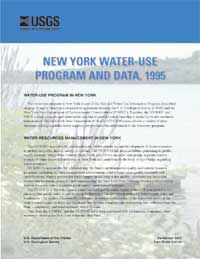 New York Water-Use Program and Data, 1995
New York Water-Use Program and Data, 1995
by Deborah S. Lumia and Kristin S. Linsey
U.S. GEOLOGICAL SURVEY
Fact Sheet FS-014-02
ABSTRACT
The water-use program in New York is part of the National Water-Use
Information Program and is based on a cooperative agreement between the
U.S. Geological Survey (USGS) and the New York State Department of
Environmental Conservation (NYSDEC). Together, the NYSDEC and USGS collect,
compile, and store water-use data to provide a data base that is useful for
water-resources management. The New York State Department of Health (NYSDOH)
also collects a variety of data elements relating to public-water supplies
and provides this information to the water-use program.
Water withdrawal refers to the removal of water from the ground or its
diversion from a surface-water source for use. In 1995, about
10,230 Mgal/d (million gallons per day) of freshwater was withdrawn from
New York's rivers, streams, lakes, and aquifers for all uses combined; this
withdrawal represents an average of more than 560 gal/d (gallons per day)
for each resident of the State.
More freshwater is withdrawn by thermoelectric plants than for any other
water-use category. Of the freshwater withdrawals within New York, about
64 percent were made by fossil-fuel and nuclear power plants; about 32
percent were for public-water supply, domestic, and commercial categories;
and about 3 percent were for agricultural, irrigation, and industrial use.
Many of New York's large population centers have developed along major rivers
and lakes; as a result, more than 90 percent of the withdrawals in 1995 were
from surface-water bodies (9,230 Mgal/d). More than 70 percent of
surface-water withdrawals were for thermoelectric-power generation, and about
27 percent were by public-water suppliers. Of the 1,000 Mgal/d of ground
water withdrawn in 1995 statewide, 55 percent was withdrawn by public-water
suppliers, and 28 percent was withdrawn for domestic and commercial uses.
Total withdrawals, and total surface-water and ground-water withdrawals, in
New York are plotted by county. The categories of public-water supply and
thermoelectric power account for the largest withdrawals (greater than
100 Mgal/d in an individual county). These withdrawals consist entirely or
mostly of surface water except in Nassau and Suffolk Counties on Long Island,
where ground water is the sole source of freshwater.
Delaware, Putnam, Schoharie, Sullivan, Ulster, and Westchester Counties, in
the southeastern part of the State, provide surface water to the aqueducts
that supply drinking water to New York City. In 1995, the average amount of
water delivered to New York City from these counties exceeded 1,300 Mgal/d.
Other counties with large withdrawals in 1995 were Onondaga County, south of
Lake Ontario, where public-supply withdrawals exceeded 140 Mgal/d, mostly
from surface-water bodies, and Monroe and Erie Counties, in western New York,
which had large surface-water withdrawals for public supply (123 Mgal/d in
Monroe County and 214 Mgal/d in Erie County) and for thermoelectric plants
(177 Mgal/d in Monroe County and 835 Mgal/d in Erie County).
All of the remaining eight counties with total withdrawals exceeding
100 Mgal/d had large withdrawals for thermoelectric-power generation. The
only counties in which ground-water withdrawals exceeded 100 Mgal/d were
Nassau and Suffolk on Long Island; these withdrawals were for public supply.
New York ranked ninth in the United States in 1995 in total withdrawals; the
States that exceeded New York in total withdrawals were those that are
large (such as California) and (or) that use large quantities of water for
irrigation (such as Colorado). In 1995, New York ranked third in total
population after California and Texas, but 40th in per-capita withdrawal
rates (about 560 gal/d per person). New York's relatively small per-capita
withdrawals, compared to those of other States, are the result of the large
total population and the low rates of withdrawal for irrigation.
New York also ranked third in total withdrawals for public supply after
California and Texas, and sixth in fresh-water withdrawals for the
generation of thermoelectric power. New York ranked ninth in total
surface-water withdrawals, but was second only to California in
surface-water withdrawals for public-water supply. New York ranked 16th in
total ground-water withdrawals and 5th in withdrawals of ground water for
public supply.
Citation: Lumia, D.S., and Linsey, K.S., 2002, New York Water-Use
Program and Data, 1995: U.S. Geological Survey Fact Sheet FS-014-02, 6 p.,
4 figs.
 [Full Report, Acrobat PDF
(808K)]
[Full Report, Acrobat PDF
(808K)]
[an error occurred while processing this directive]
|
